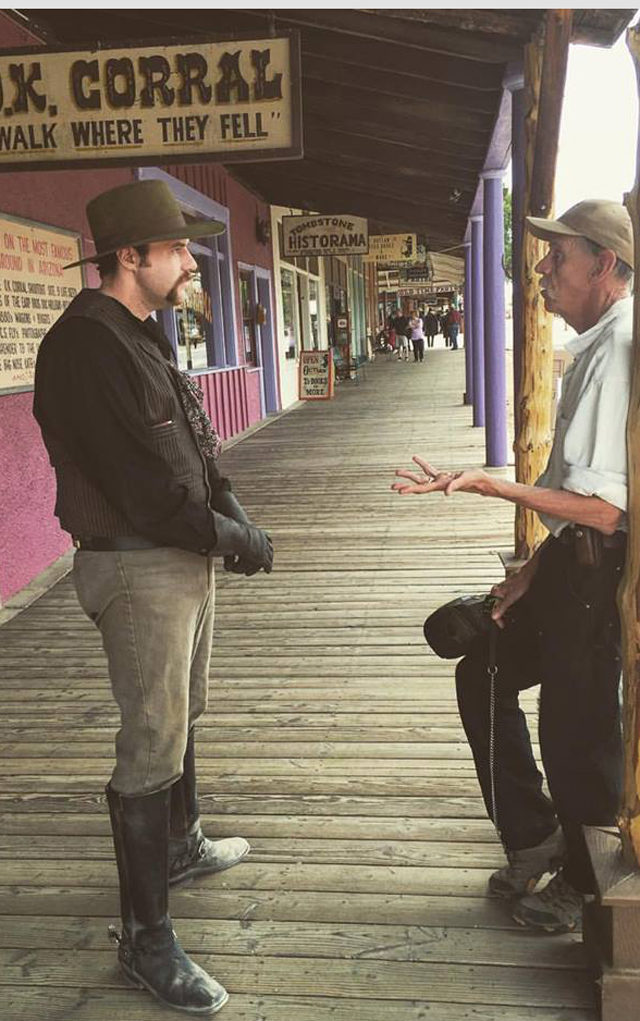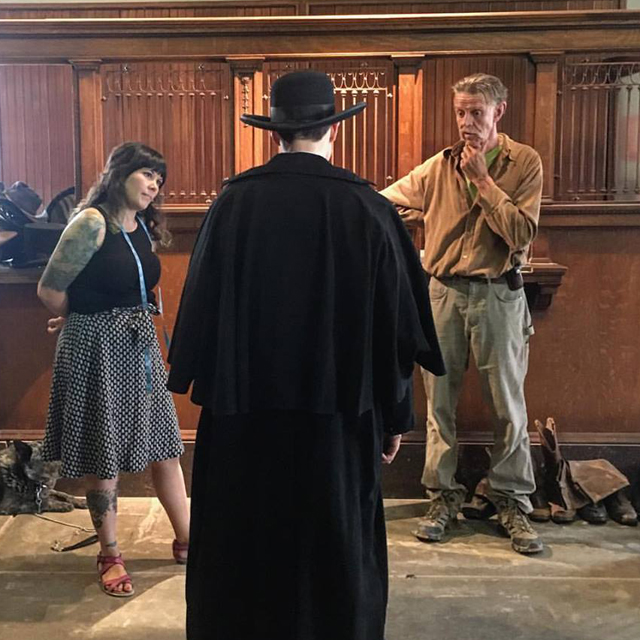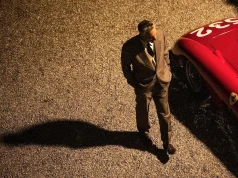
Few filmmakers are as devoted to cinema as Alex Cox. Since his debut in 1984, Cox has made movies for the studios, for BBC’s Channel 4, for Roger Corman, for his students and for himself. He’s penned three books on movies, taught screenwriting at the University of Colorado Boulder and back in 2015, he retired to the woods of Oregon to write and live. But the woods didn’t hold him long and last year he ventured to the Arizona desert to film his latest movie, Tombstone-Rashomon, a passion project that dates back to his days as a high schooler.
Even passing fans will recognize Tombstone as home to one of the most famous shootouts in the American West: the Gunfight at the O.K. Corral. The activity took all of 30 seconds and when all was said and done, Tom and Frank McLaury and Bill Clanton lay dead in the dust while Doc Holliday and the Earp brothers —Virgil, Morgan and Wyatt — all stood victorious. According to the history books, it’s the moment when the law pushed back against the lawlessness of the frontier and what transpired on Wednesday, Oct. 26, 1881 has become the stuff of legend.
But legends have a way of being manipulated. Were the Earps, and temporary policeman Holliday, justified in their actions? Did the Clanton and the McLaury brothers have it coming to them? Were they set up?
“When I was a teenager … I read Stuart N. Lake’s Wyatt Earp: Frontier Marshall,“ Cox tells Boulder Weekly. “It’s such a romantic story. It’s so heroic and so prejudice in favor of the Earps and Holliday — I thought, ‘What a great story! I’d like to make this as a film.’”
Nearly five decades later, Cox’s teenage fantasies have come to fruition, but not without a little inspiration from his students. During Cox’s tenure at CU, he crowdfunded a feature film adaptation of Harry Harrison’s Bill, the Galactic Hero and used his students to bring it to the screen.
Bill was funded by a successful Kickstarter campaign, one that gave Cox hope that there might be a new way to make movies. But as Cox quickly learned, the science fiction of Bill proved an easier sell than the Western style of Tombstone-Rashomon.
“When I saw how little money we raised, [I thought] ‘We are so screwed, man!’ Cox says with a hearty laugh. “We were so screwed because we had no money at all.”
Cox and company adjusted their already micro budget to $50,000 but still only managed to raise $31,642 with 297 backers on Indiegogo. Not nearly enough to tell their Tombstone story with the ambition Cox had in mind. Thankfully, friends in high places came to the rescue.
“We were really lucky because a video streaming company, Fandor, came in and added to the budget,” Cox explains. “Then the producers of Snowden and the Iggy Pop documentary, Gimme Danger, also came in and matched what we raised from Indiegogo and Fandor. So, it was still minimal but at least we could afford to feed people and have horses.”
And with a crew of roughly 60 people, Cox set off to Old Tucson Studios to shoot his version of the Gunfight at the O.K. Corral, only his version would be a spin on the nature of narrative and drew inspiration from Akira Kurosawa’s 1950 seminal film about conflicting firsthand accounts, Rashômon.
“The style of Rashômon is perfect for this because there are these conflicting testimonies and you have no real way of knowing who is telling the truth,” Cox explains.
Cox based his script on the testimony the survivors gave following the shooting. To recreate this visually, Cox uses interviews from the surviving participants to introduce each account — seen here in flashbacks — of the shooting and what caused it.
“I really wanted to parody the Errol Morris style,” Cox says of the interviews. “Where you bring in that cheesy piece of gray cloth and hang it behind the person, and then have them look down the barrel of the camera as if that conveys truth.”

Designer
Samantha Toney with Alex Cox
working on Doc Holliday. Merritt Crocker
But no specific account of an event can be labeled “The Truth” and to convey that, Cox and his editor and producer, Merritt Crocker, utilized various visual cues.
“Every character has a different color palette for their flashbacks,” Cox explains. “One of them is magenta oriented, one of them is very saturated, one of them is black and white … Everyone recalls things with a somewhat different visual aspect.”
Though truth, notably personal truth, forms the crux of Tombstone-Rashomon, the movie is more than a series of first-hand accounts. It’s also about how we cast heroes and villains in our mind, even if they aren’t cut and dry in reality.
“We played around a little bit with the idea that in the course of the interview [the interviewers] picked a side and the side was Wyatt Earp,” Cox says. “You see them kind of working with Earp to make him more heroic. … You see how the media create heroes and villains.”
That creation of Earp as the hero — specifically his connection to the law — is what makes Tombstone-Rashomon prescient in 2017.
“We showed the film in Tucson at The Loft [Film Festival], and it played immediately after a documentary about militarized policing in the U.S. called Do Not Resist,” Cox recounts.
“After the screening of Do Not Resist, they had a panel discussion with civil liberties people, the chief of police, and then they showed Tombstone-Rashomon,” Cox continues. “It was actually a very good double bill because a lot of what our film is about is: How do you police a population which has no respect for the police, and no reason to respect them, and is armed?”
That connection between the past and the present is what makes Tombstone-Rashomon work, both as a parable and as an entry into the oeuvre of Alex Cox.
“Films aren’t just dioramas to be put in the museum,” Cox says. “Films are a part of our contemporary existence. Films should reflect the world in which we live. When you’ve got things that are so obviously parallel, it seems to me a lost opportunity if you don’t jump on it.”
On the Bill: Tombstone-Rashomon, with director Alex Cox. International Film Series, Tuesday, Feb. 28, 7:30 p.m. Muenzinger Auditorium, University of Colorado Boulder, 1905 Colorado Ave., Boulder, 303-492-8662, internationalfilmseries.com.














